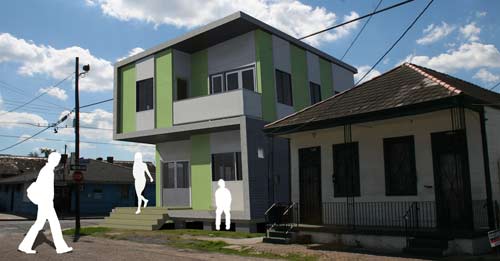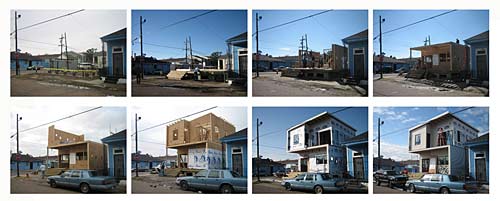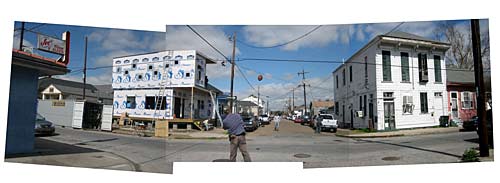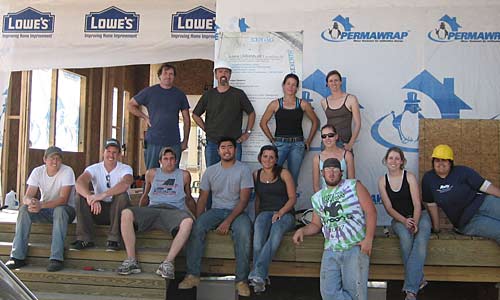Correction appended March 25, 2008
When Tulane University architecture students were first presented last fall with the dimensions of the tiny lot in New Orleans’s Ninth Ward that their URBANbuild prototype house would occupy, they knew the scheme for their design/build project would have to be tight. But the test of their ingenuity was kicked up a notch when it turned out that the lot was five feet smaller than it was supposed to be. Still, the fourth-year students managed to configure a three-bedroom, two-bath house on a lot less than 30-by-57 feet in size. Icing on the cake was the parking space they squeezed into the 1,200-square-foot project.
 A rendering of the third house designed by the Tulane School of Architecture’s URBANbuild program. Images courtesy Tulane School of Architecture |
“When we first saw the lot we knew it would have to go up two stories,” says Adriana Camacho, the Tulane School of Architecture student whose drawings fellow URBANbuild students voted to build for their house, whose construction is due to finish in May. “When we found out that it was smaller than it was supposed to be, we also knew there would be no room for anything not to work as we designed.”
One clever design strategy turned the staircase into built-in furniture. It holds kitchen storage on one side and a unit for entertainment equipment on the other side. The inventive placement of windows throughout the house offers abundant light while providing privacy for occupants of the structure, which occupies a corner lot. Access to outdoor space from nearly every room also opened the tight floor plan.
 Under construction now, the house is due to be completed in May. |
The house is the third in the URBANbuild program, created shortly before Hurricane Katrina nearly decimated the city’s stock of affordable housing. After the storm, Tulane redoubled its effort to design models for low-cost, sustainable residences by teaming with Neighborhood Housing Services (NHS), a nonprofit that helps low-income families buy houses.
“This partnership forces the students to work within the confines of the lots, budgets and housing requirements that we give them,” says Lauren Anderson, the nonprofit’s executive director. “They will be better architects because of this experience working with these tight parameters.”
 The house occupies a narrow corner lot in New Orleans’s Ninth Ward. |
NHS provides the lots, usually substandard parcels purchased from the city, and pays for construction materials from a revolving loan fund that is repaid when homebuyers get their mortgages. The blueprints and labor are free, which helps the cost of these custom-designed residences remains below $100 per square foot. URBANbuild’s long-term goal is to expand the program to other neighborhoods.
With each new design/build project have come fresh goals and challenges. The current house was built using structurally insulated panels for a faster build-out and optimum energy efficiency. With one previous prototype projects students had experimented with steel-frame construction and for another they used conventional stick built methods. Modular construction techniques were used for a house built by students in GREENbuild, a sister program at Tulane’s School of Architecture.
 The team of fourth-year architecture students at Tulane University constructing this year’s URBANbuild project. |
Correction: The third URBANbuild house is actually located in New Orleans's Central City neighborhood.


Post a comment to this article
Report Abusive Comment